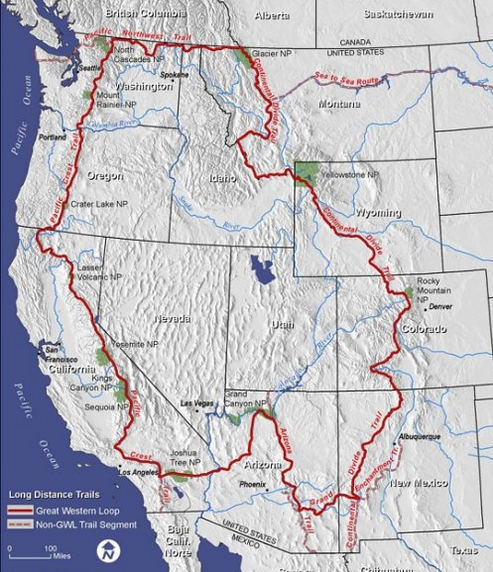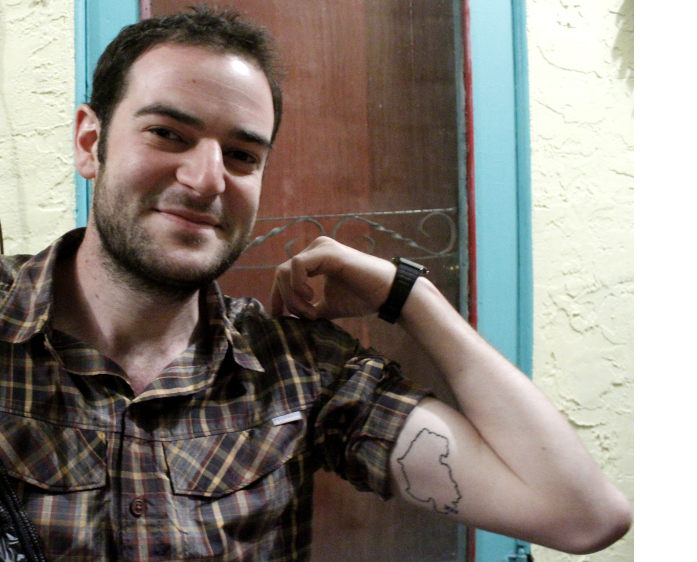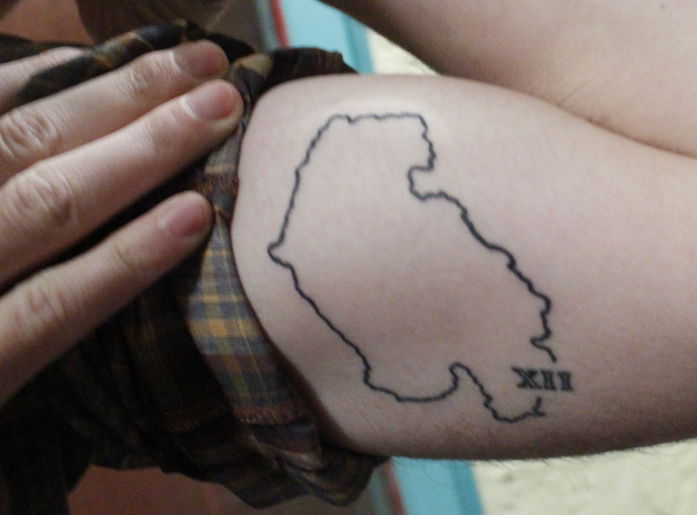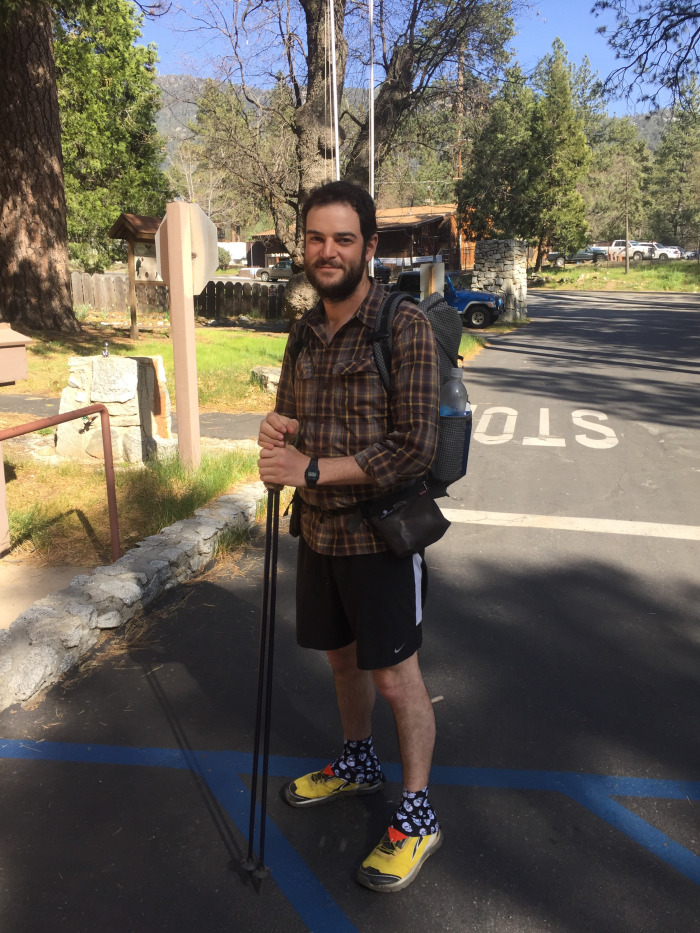It all began with a cardboard tube. A giant cardboard tube, addressed to “Oscar Rubio”. At work I have a foible about people who use our hostel address for their mail. Over the years the bulk of mail has grown exponentially with long forgotten visitors. When this over-sized package arrived for someone not even checked in to the hostel, my wrath had been invoked before we had even met.
Off duty, I was lounging at front desk chatting with staff when I met a beaming 20-something with easy charm. He said “I think you have a tube for me.” I was taken aback.
“Oh. You’re Oscar of the tube.” I remarked merely hinting my previous irritation and more curious about this smiling traveller than angry at all.
“Yes, that’s me.”
“We’ve all been been wondering. What is in there?”
Oscar with some mystery, said he’d show us. Glowing with pride he released two science-fiction, purple coloured sticks from the tube.
“Hiking sticks! Feather-light carbon fiber! Here, hold them and see!”
In turn I and the hostel staff lifted the shiny purple sticks that were indeed feather-light. So light in fact, it seemed pure fairy-magic that these items could exist taking the volume they did. I waved them around uncontrollably, seemingly unable to regulate my muscle to the evidence of my eyes.
“And what are you off to do with these beauties?” I asked.
“It’s a long story, but I’m hiking the Pacific Crest Trail and the Continental Divide Trail, well and a few more in a loop actually. I hope to make it back here in seven months.”
A bold adventurer! I immediately forgave the postal faux pas, and decided this bright fellow was curious enough to be questioned. Offering beer on the porch I invited him to chat with me later that evening.
Oscar is twenty five, originally from Mexico City and studied Economics in Chicago. His custom hiking trip is a montage of more famous trails glued together by other enthusiasts (or adventurers as Oscar prefers to name them) and his own research.

The Great Western Loop, as it has been called, connects established trails including the Pacific Crest Trail, the Pacific Northwest Trail, the Continental Divide Trail, the Grand Enchantment Trail, the Arizona Trail, and a section between the Arizona Trail and the Pacific Crest Trail across the Sonora and Mojave deserts.
I ask about his previous experience. Smiling bashfully he explains “I’ve actually never done one of the long trails. Last year I wasn’t doing anything at all. I used to like camping but I worked in an office. That was until December 2013 when I quit my job to take a course in expedition leading. After the course I started leading groups in South America for six months, in Peru and Ecuador.”
So how does a young, talented professional suddenly change tack and decide to do something completely different?
“I think I was always interested in doing something more adventurous. I was a research economist. I started work straight after college and I thought this was the best place for me, but I found I was sitting in the office all day with just a couple of weeks vacation here and there. I liked what I was doing, I just didn’t like it was all I was doing.”
The expedition leader course gave Oscar the enthusiasm for adventure. “It taught me how to solve problems, in the middle of nowhere. It’s very difficult physically, mentally. Some of it is survival, or you may need to know how to evacuate a person, ultimately it’s all your responsibility.”
A pivotal event in his training was a trek to Victoria Peak in Belize. It was an optional hike, not part of the curriculum. The British army who had previously provided support for hikers had left, so if anything went wrong you’d be on your own.
“Ten out of the eleven in my group said OK. Then one of the guys said he’d rather use the free time to visit Guatemala. When vacation versus ‘mountain that might kill us’ became the choice, only three of us ended up going.”
This trip was planned for three days, for a total of 26km each way. Day one would take them from kilometer zero (a hiker shorthand term I quietly assumed) to kilometer 19, the next day kilometer 19 to the summit and back, and the third day from km19 to km0 again.
Oscar and friends Dan and Adam began the trip began a little later than planned. When they arrived early on at a camp situated at km12, Dan suggested “Maybe if we leave our stuff here, we’ll be able to get to the peak, since we can’t sleep without our stuff.” The group knew some other people had made the trip in two days, so they weren’t worried. Oscar added “Km0 to km12 was so easy we figured we could do it.” They merrily repacked, leaving the majority of their food and their camping equipment, and set off.
Things changed from km12 to km19 when the terrain became a great deal tougher. Oscar called it “insane”.
“It took so much longer, there were roots and mud everywhere, we kept slipping, and my knees were inexplicably hurting.” But they persisted and exhausted, reached the summit at 3pm. However the decent turned out to be just as exhausting as the ascent.
“Adam who I thought was the strongest person I’d ever met before that, was actually hugging trees to not fall down or fall asleep when we were taking breaks.”
At the km19 camp they knew that if they had left their things there they would have stayed there to sleep.
“None of us had any energy. We also miscalculated how much food to bring so we were hungry. I had brought spare batteries but no flash light. I was very prepared, with my spare batteries.” Oscar laughs.
“It was getting dark but we kept walking. Eventually we got to the camp where we’d left our stuff at km12, near midnight. Once we were there we thought, we’ve made it this far, let’s keep going and do it all in one day. So we boiled water and cooked all our hot food since we had dinner left for 3 days. We ate so much food, and slept for about an hour, and then we set back out for where we started.”
“It was 5am when we got back, so we walked for about 22 hours.”
This testing experience made him realise that “On that day none of us were actually able to do that. It’s entirely that we left our things, the commitment was the deciding factor.”
When I ask about the physical demands of such a hike Oscar explains “First it’s pain, I had a lot of joint pain. Also I’ve never felt my heart beat like that. Three quarters of the way through, I felt my heart bouncing out of my neck. I remember when I could see an uphill stretch my heart would start beating in anticipation and I was thinking ‘What is this?’.”
It seemed to me the group dynamic would have been instrumental in attempting and completing this challenge and Oscar agrees. Dan, he said, was like the “energiser bunny, bouncing around everywhere” and Adam, well Adam clearly wasn’t himself and in a way Adam’s difficulty had given Oscar more confidence in his own ability.
On the way home they sat at a picnic table waiting to get the bus back to base camp, and Oscar remarked how incredible it was that none of them had ever suggested they stop to sleep. “We knew how to make shelters, we could have slept. Then Adam said quietly ‘I thought it all the time.’.”
Oscar laughs, “I think we all did but no one said it.” After a pause he adds thoughtfully “Adam’s from Yorkshire.”

Oscar found out several weeks after the trip that he was harbouring a tick. Once he removed the tick, the joint pain stopped. I’m horrified at the idea of ticks and Oscar laughs at my disgust “In the time I was on that trip I probably had a hundred ticks. I just missed one of them.”
Knowing that now Oscar’s challenge won’t be a team effort I ask him how he will handle the tough times this long haul trip will deliver? Oscar references one of his favourite (blogging) adventurers Alastair Humphries. “He has a system for this, he promises himself that he won’t quit when he is having a bad time. If it is raining or snowing, too cold or too hot, he’ll wait until it’s a nice morning, he’ll have a nice cup of coffee and he’ll think about it. Then if he still wants to quit, it’s ok to go home. Inevitably every time he had a coffee and it was nice, he didn’t want to go home! I think that’s part of it. Remember why it’s important.”
This brings up a key question for me, what the point of this trip is, and Oscar too realises he doesn’t have a confident sound bite for his motivations, “There is a ‘why’ but I am not sure what it is yet.” We both decide that maybe the point becomes apparent in the doing.
Oscar offers some wisdom he received from an older man he met at a conference recently. When Oscar explained the trip to him “I thought he’d ask me why did you quit your job to do this? But he said that now people live a lot longer, his grandchildren will probably live another 20 years more than him, and we need to figure out what to do with those extra 20 years. He said ‘I think a year of walking alone is a good use of one of those twenty years’.”
Oscar too would like to find a way to make money from these adventures that he loves, and this expedition may be the testing ground for whether there is a way to be a full-time adventurer. We discuss sponsorship but unsurprisingly it’s hard to secure a good deal especially when you don’t yet have a track history.
That said, Oscar has set up a blog OscarsAdventures.com in which he’s writing about the journey.
“I want to make the most out of it personally, so I want to write about it for myself, but I also want to use it to help my aspiring adventure career. I want to write a book too, I’m not sure how it’s going to look but I’m taking notes every day and eventually it will come together.”
I ask if he’s confident he’ll make it all the way around, and he says he thinks he will partly because he’s provided himself some space “One extra mile a day in the middle could give me three days extra at the end. I can adapt. “
I notice Oscar often uses metrics and calculations when he’s talking about the trip, so I ask him if this is a legacy from his previous occupation as a statistician. He laughs, “I have seen the economist in me come out, so for instance before I started buying things I made a spreadsheet with weights and prices, and I fiddled with it for a month before I made my decisions. Some people plan where they will camp every night, but if you’re walking for a really long time I don’t think that matters. I’ve learned to be a little lazy and let go of the things that don’t matter or that will probably change.”
Finally still aware of his isolation, I ask about how his family and friends have responded to his adventure.
“They understood. Because I had already quit my job last year, they had thought that more insane. I think it was the the way I told them that made them realise how important it is for me. Also I got a tattoo of the route one day when I was having lots of doubts about if I could do it. Having the tattoo made it obvious it was important. I hope I don’t fail now!”


This story would be remiss without adding that when Oscar left for the start of the loop in early March, it wasn’t the last I’d see of him.
I’d followed his blog and noticed he had been experiencing difficulties on the Enchantment Trail, the beginning of the loop from New Mexico to Arizona. It had been freezing at night and his hikes had become plagued by joint pain and loneliness. A great illustration of this is in his post Imaginary friends, where he follows in the footstep of another unseen hiker, deconstructing the other man’s journey and physical condition by the location and depth of his footprints in the snow.
Two weeks after bidding Oscar a fond farewell, as I walked through the hostel a familiar voice said “Hello again!” It took me a few seconds to fully realise here was Oscar again, back in sunny Albuquerque. Not at all where I was expecting him to be.
He told me in summary “I was losing motivation because I was alone and I felt unprepared for the cold nights.” Also, although his plans were loose, his own daily milage expectations had become a cruel mistress. He realised he just wasn’t enjoying the walking anymore. So, he decided to re-route himself to begin the hike (again) from Mexico at the Southern most most point of the Pacific Crest Trail. Here he would have more company and more clement weather that would allow his body to adjust to the daily demands.
In his blog post Bumps in the road, he noticed that “commitment as a strategy” such as having a tattoo of the route, wasn’t enough to get him through. To me, this early set-back was actually a set-forward for Oscar. He is learning valuable lessons about himself, about motivation and about his own unique needs physically and mentally. Seeing what isn’t working, changing plans but still going on is how he’s chosen to tackle this, and that in itself is inspirational to me.
As of writing, I can see he’s doing well. His his geo-locator map shows he camped last night Northeast of Los Angeles at Silverwood Lake, a reservoir in San Bernardino County. I’m still not sure why he’s doing it (neither apparently is he) but it’s a pleasure to share this journey with him through his writings, and especially to see what new mountains internal and external will challenge him next.

Love it! 🙂
I went and saw the BANFF http://www.banffcentre.ca/mountainfestival/ film festival yesterday. The reasons people gravitate to crazy journeys and epic adventures all seem to be the same … its the scenery and the things that might kill you along the way vary 🙂